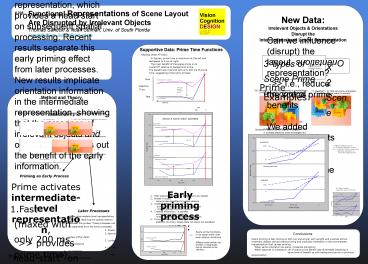Functional Representations of Scene Layout Are Disrupted by Irrelevant Objects Thomas Sanocki - PowerPoint PPT Presentation
Title:
Functional Representations of Scene Layout Are Disrupted by Irrelevant Objects Thomas Sanocki
Description:
Irrelevant Objects & Orientations Disrupt the Intermediate-level Layout Representation Functional Representations of Scene Layout Are Disrupted by Irrelevant Objects – PowerPoint PPT presentation
Number of Views:33
Avg rating:3.0/5.0
Title: Functional Representations of Scene Layout Are Disrupted by Irrelevant Objects Thomas Sanocki
1
Functional Representations of Scene LayoutAre
Disrupted by Irrelevant ObjectsThomas Sanocki
Noah Sulman, Univ. of South FloridaSanocki_at_usf.ed
u, Sulman_at_mail.usf.edu
New Data Irrelevant Objects Orientations
Disrupt the Intermediate-level Layout
Representation
Vision Cognition DESIGN USF
295
Can we influence (disrupt) the layout
representation? gtgt I.e., reduce the scene prime
benefits We added irrelevant objects to the
scene primes, which disrupt the purity of the
layout information.
Supportive Data Prime Time Functions
Overview Brief exposure to a scene prime
activates an intermediate-level representation,
which provides a head start on subsequent spatial
processing. Recent results separate this early
priming effect from later processes. New results
implicate orientation information in the
intermediate representation, showing that the
presence of irrelevant objects and orientations
cancels out the benefit of the early information.
Reading these RT Data
3 Types of Scene Prime (no control prime) 1.
Scene prime only, and scene prime with
irrelevant objects, either 2. Same orientation
as prime and target (X) 3. Inverted relative to
prime and target (IXI)
In figures, prime time is maximum at the left
and decreases to 0 ms at right. The main
benefit of the scene prime is its overall RT
relative to background prime. The benefit was
maximal with only 200 ms of prime time,
suggesting a fast early process
X 2 Scene
one of 4 pairs of irrelevant objects appeared
randomly
Orientations
slow Reaction Time fast
Background / control
Prime Examples
Relative benefit of scene prime
IXI /upright - Irr Objs are opposite in
orientation to prime/target scene (which were
both upright)
X /inverted - Irr Objs are same orientation as
prime/target scene (inverted)
Method and Theory We show the method for each
trial and discuss the assumed processes.
Scene prime
800 ms 400 200 0 ms Prime
Time
Events on Each Trial
1. Fixation
3. Target, until right/left oval closer
reaction time response
2A. Scene prime
(Irrelevant objects did not appear in target)
RT
2B. Background / control prime
ltlt KEY (examples above) X Irrelevant objects
in prime IXI Irrelevant objects misoriented
(opposite orientation to prime
and target scene)
RT
800 ms 600 400 200 0
Prime Duration
Fixation prime 1200 ms total time
Priming as Early Process
Prime activates intermediate-level
representation, gtgt provides head-start on
target processing, resulting in faster RT
responses. Early processes are (see data in
middle column)
Full data (noisier) means for each prime time
Early priming process was
- Fast (required only 200 ms prime time to be
maxed) - Broad in scope scene primes benefited 16
spatial relations - Created efficiently / in parallel prime time
functions similar for upright and inverted
scenes, as shown above - Created efficiently / in parallel prime time
functions similar for simple and complex
scenes, as shown below - Priming independent of target difficulty
additivity of prime x target (data not shown but
available)
- Fast (maxed with only 200 ms prime time)
- Broad in scope gt entire scene had 16 spatial
relations - Created efficiently / in parallel gt no effect
of scene complexity - Created efficiently / in parallel gt no effect
of scene inversion - Priming independent of target difficulty
- Priming not sensory (Sanocki, 2003)
Later Processes
Refine intermediate-level representation,
eventually resolving the spatial relation between
the probes. These processes can be separated from
the early processes 1. Slower 2. Narrow scope
(other data) 3. Limited by complexity 4.
Limited by inversion 5. Longer with difficult
targets
Scene prime functions in an experiment with even
shorter durations. (Effects were quicker
but smaller in magnitude, due to reduced
prime validity.)
ltlt
Scene priming is fast (strong at 200 ms) and
similar with upright and inverted
stimuli. Irrelevant objects disrupt scene priming
and implicate orientation in the intermediate
representation that causes priming When
same orientation as scene, moderate disruption
When opposite in orientation, all of scene
prime benefit was eliminated (resulting in same
level of benefit as with background prime in
previous experiments).































